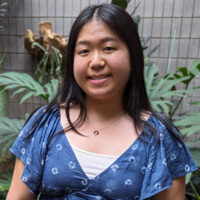
Investigating BdWOX3 and BdLG1 protein accumulation and their mutant phenotypes
In grass model systems, particularly Zea mays (maize), leaf development has been extensively studied through genetic approaches. Maize double mutants narrowsheath1/2 (ns1/2) fail to recruit founder cells to make the leaf margin, resulting in a skinnier sheath and blade. liguleless1 (lg1) mutants do not develop the ligule or auricle, resulting in upright leaves. However accurate fluorescent protein (FP) marker lines corresponding to LG1 or NS1/2 in maize have been difficult to generate, likely due to cryptic promoter sequences being far up- or downstream that are required for proper gene expression. Brachypodium distachyon is a model grass system with a much smaller genome than maize and therefore the potential for less complex gene regulation. As such, B. distachyon is a great candidate for developing FP markers lines for the study of proteins of interest involved in leaf development. This project utilized confocal imaging of FP marker lines to determine protein localization of BdWOX3 and BdLG1 (orthologous to maize NS1/2 and LG1, respectively). Leaf development in wild-type, Bdwox3 and Bdlg1 was examined and compared to maize wild-type, ns1/2 and lg1 mutant phenotypes to document differences between these systems. We observed a previously undescribed lg1 trichome phenotype in B. distachyon. Leaf wrapping patterning was found to differ in B. distachyon compared to other grass systems. Our findings act as the foundation for elucidating gene functions of BdWOX3 and BdLG1 in B. distachyon. These results present B. distachyon as a promising grass system to study leaf development in through genetic mutants and FP marker line tools.\
Over the course of this program, I gained many skills in plant developmental research that are applicable to the work I am doing at my home university and what I would like to study in the future. The program has also provided opportunities to learn about topics that I had never studied before and has made me even more excited about research. I enjoyed learning how to navigate this new lab environment and have met so many amazing people that have helped me along the way. Through lab presentations and other forms of scientific communication, I feel more confident in my ability to discuss my research clearly. I have also learned a lot about graduate school, and what it might offer me in the future. After this program, I plan on continuing to study plant science and apply for PhD programs for graduate school.
